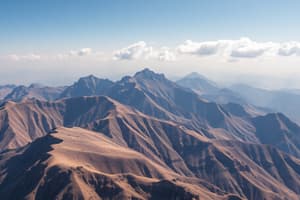Podcast
Questions and Answers
What is the primary focus of physical geography?
What is the primary focus of physical geography?
- Natural features and processes (correct)
- Urban development and management
- The utilization of geospatial technologies
- Human societies and their cultures
Which term refers to how people and environments influence each other?
Which term refers to how people and environments influence each other?
- Scale
- Place
- Region
- Interaction (correct)
Which of the following outlines areas defined by common characteristics?
Which of the following outlines areas defined by common characteristics?
- Place
- Space
- Scale
- Region (correct)
What does urbanization primarily refer to?
What does urbanization primarily refer to?
Which skill is essential for interpreting various types of maps?
Which skill is essential for interpreting various types of maps?
What are geospatial technologies primarily used for?
What are geospatial technologies primarily used for?
Which of the following is a significant human impact on the environment?
Which of the following is a significant human impact on the environment?
Which climate zone is characterized by hot and dry conditions?
Which climate zone is characterized by hot and dry conditions?
Flashcards are hidden until you start studying
Study Notes
Definition
- Geography: The study of the Earth's landscapes, environments, and the relationships between people and their environments.
Branches of Geography
-
Physical Geography:
- Focuses on natural features and processes (landforms, climate, ecosystems).
- Studies the earth's physical landscape and natural phenomena.
-
Human Geography:
- Explores human societies, cultures, economies, and their interactions with the environment.
- Examines spatial aspects of human existence.
-
Geospatial Technologies:
- Utilizes tools like GIS (Geographic Information Systems), GPS (Global Positioning System), and remote sensing for mapping and analysis.
Key Concepts
- Place: Physical and human characteristics that define a location.
- Space: The physical distance and arrangement between objects/places.
- Scale: The level of detail or scope at which geographic phenomena are observed (local, regional, global).
- Region: Areas defined by common characteristics (cultural, political, physical).
- Interaction: How people and environments influence each other.
Major Physical Features
- Landforms: Mountains, valleys, plateaus, plains.
- Water Bodies: Rivers, lakes, oceans, seas.
- Climate Zones: Tropical, arid, temperate, polar climates.
Human Impact
- Urbanization: Growth of cities and its socio-economic implications.
- Environmental Management: Sustainable practices to mitigate human impact on the environment.
- Cultural Landscapes: How human activity shapes and alters the natural environment.
Tools and Techniques
- Cartography: The art and science of map-making.
- Field Studies: Direct observation and measurement in geographical research.
- Statistical Methods: Analyzing and interpreting geographical data.
Key Skills
- Map Reading: Understanding and interpreting various types of maps.
- Spatial Analysis: Assessing relationships and patterns in geographical data.
- Critical Thinking: Evaluating geographic phenomena and human-environment interactions.
Importance of Geography
- Helps understand global issues (climate change, migration).
- Provides insights for planning and resource management.
- Enhances awareness of cultural diversity and global connections.
Geography
- Definition: The study of the Earth's surface, encompassing its landscapes, environments, and the intricate relationship between people and their surroundings.
Branches of Geography
- Physical Geography: Focuses on Earth's natural features and processes like landforms, climate, and ecosystems.
- Human Geography: Explores human societies, their cultures, economies, and the way they interact with their environment.
- Geospatial Technologies: Utilizes tools like GIS (Geographic Information Systems), GPS (Global Positioning System), and remote sensing for mapping and analyzing geographical data.
Key Concepts in Geography
- Place: Defined by a location's unique physical and human characteristics.
- Space: Refers to the physical distance and arrangement between objects or places.
- Scale: The level of detail or scope at which geographic phenomena are observed, ranging from local to regional and global.
- Region: Areas characterized by common characteristics, which can be cultural, political, or physical.
- Interaction: The dynamic interplay between people and their environment, where each influences the other.
Major Physical Features
- Landforms: Include mountains, valleys, plateaus, and plains.
- Water Bodies: Encompass rivers, lakes, oceans, and seas.
- Climate Zones: Vary across the globe, encompassing tropical, arid, temperate, and polar climates.
Human Impact on the Earth
- Urbanization: The growth of cities and its significant socio-economic implications.
- Environmental Management: Sustainable practices designed to mitigate human impact on the environment.
- Cultural Landscapes: The ways in which human activities shape and alter the natural environment.
Tools and Techniques of Geography
- Cartography: The art and science of map-making.
- Field Studies: Involve direct observation and measurement in geographical research.
- Statistical Methods: Used to analyze and interpret geographical data.
Key Skills in Geography
- Map Reading: The ability to understand and interpret various types of maps.
- Spatial Analysis: Assessing relationships and patterns within geographical data.
- Critical Thinking: Evaluating geographic phenomena and human-environment interactions.
Importance of Geography
- Provides crucial understanding of global issues such as climate change and migration.
- Offers crucial insights for planning and resource management.
- Enhances awareness of cultural diversity and global connections.
Studying That Suits You
Use AI to generate personalized quizzes and flashcards to suit your learning preferences.




